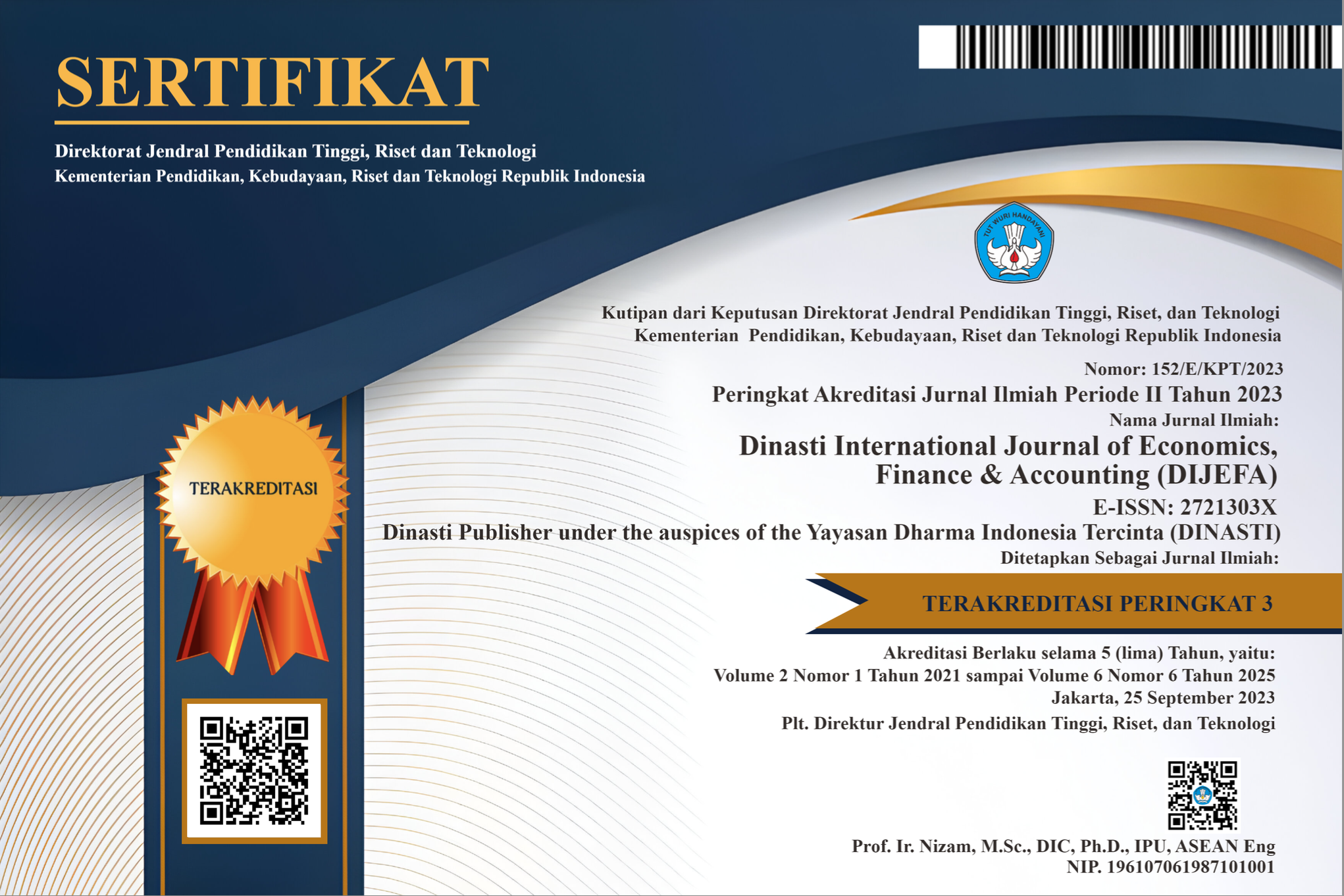Syirkah Model For Islamic Gold Monetization
DOI:
https://doi.org/10.38035/dijefa.v5i2.2488Keywords:
Musharakah, Rahn, Asset Refinancing, GoldAbstract
This study proposes a syirkah model for gold monetization as a product innovation opportunity alternative in Islamic Financial Institutions (IFI) towards bullion bank activity implementation because of Act of Law No. 4 of 2023 about P2SK. A descriptive qualitative approach was used in this study of fiqh literature from Shariah Standard No. 57 on gold trading and its trading control released by the World Gold Council and AAOIFI, as well as Fatwa DSN MUI for Musharakah contract. This study was also validated by semi-structured interviews. To clearly define the originality, we use simulation to present and compare the concept with an existing gold-based pawn contract (Ar-Rahnu). Risk-adjusted calculation to protect the initial value. The result shows that this syirkah model can be an alternative to productive gold investment.
References
Accounting and Auditing Organization for Islamic Financial Institutions (2008). The AAOIFI Shariah Standards No. 57 on Gold and Its Trading Control Manama: AAOIFI.
?bid?n, M.A.U.I , ?a?kaf?, M.A .(2011).Hashiyat ibn 'Abidin: radd al-muhtar 'ala al-Durr al-mukhtar
Dar al-Ma'rifah
Al-Amine, M.A.B. (2015), “Product development and maqasid in Islamic finance: towards a balanced methodology”, IRTI Working Paper. DOI: 10.12816/0012263
Al-Amine, Muhammad Al-Bashir. (2015). Product Development and Maq??id in Islamic Finance: Towards a Balanced Methodology. Islamic Economic Studies, Vol. 23, No. 1, 2015, SSRN: https://ssrn.com/abstract=3156995; DOI: 10.12816/0012263
Al-Imrani, Abdullah. (2006). Al-‘Uqud al-Maliyah al-Murakkabah . Kairo: D?r Kun?z Ishb?liy? lil-Nashr wa-al-Tawz??
Aggarwal, R. K. and Yousef, T. (2000), ‘Islamic banks and investment financing’. Journal of money, credit and banking Vol. 32, No. 1 (Feb., 2000), pp. 93-120 (28 pages). Published By: Ohio State University Press. https://doi.org/10.2307/2601094
Arbouna, M.B. (2007), “The combination of contracts in shariah: a possible mechanism for product
development in Islamic banking and finance”, Thunderbird International Business Review, Vol. 49 No. 3, pp. 341-369. https://doi.org/10.1002/tie.20147
Asutay, M. (2007), Conceptualisation of the second-best solution in overcoming the social failure of islamic finance: Examining the overpowering of homoislamicus by homoeconomicus, IIUM Journal in Economics and Management Vol. 15(2), 167–195. SSRN: https://ssrn.com/abstract=1693608
Asutay, M. (2012), ‘Conceptualising and locating the social failure of islamic finance: Aspirations of islamic moral economy vs the realities of islamic finance’, Asian and African area studies. Vol 11(2), 93–113. https://doi.org/10.14956/asafas.11.93
Azis, Riza Pahlavi Abdul., Gintzburger, Anne Sophie. (2009) Equity Based, Asset-Based and Asset-Backed Transactional Structures in Shari‘a-Compliant Financing: Reflections on the Current Financial Crisis. Economic Papers, Vol.28, No.3, September, 2009, 270–278. The Economic Society of Australia. doi:10.1111/j.1759-3441.2009. 00035.x
Az-Zuhaili, Wahbah. (2011). Fiqih Islam Wa Adillatuhu Jilid 5, Jakarta: Darul Fikir
Baur, D.G. and Lucey, B.M. (2010), Is Gold a Hedge or a Safe Haven? An Analysis of Stocks, Bonds and Gold. Financial Review, 45: 217-229. https://doi.org/10.1111/j.1540-6288.2010.00244.x
Baur, D.G., & McDermott, T.K. (2013). Financial Turmoil and Safe Haven Assets. ERN: Other Microeconomic s: Decision-Making under Risk & Uncertainty (Topic). http://dx.doi.org/10.2139/ssrn.2004796
Bowers, M.R. (1986), ‘The new product development process: a suggested model for banks’, Journal of Retail Banking, 8(1), pp. 19-24.
Bowers, M.R, (1987), Developing New Services for Hospitals: a Suggested Model, Journal of Health Care Marketing, 7(2): pp. 35-44. https://api.semanticscholar.org/CorpusID:166631406
Bowers, M.R. (1989), ‘Developing new services: improving the process makes it better’, Journal of Services Marketing, 3(1), pp. 15-20. https://doi.org/10.1108/EUM0000000002478
Bryman, A. and Bell, E. (2007) Business Research Methods, London, Oxford. University Press.
Bullion Bulletin. (2015), “Q&A with Erkan Kilimci, ED, Central Bank of Republic of Turkey”, 12th India International Gold Convention, Bullion Bulletin.
Cooper, R.G. and de Brentani, U. (1991), New industrial financial services: what distinguishes the winners, Journal of Product Innovation Management, 8: pp. 75-90. https://doi.org/10.1111/1540-5885.820075
Coulon, Y. (2022). Asset-Based Approach to Valuation. In: Small Business Valuation Methods. Palgrave Macmillan, Cham. https://doi.org/10.1007/978-3-030-89719-2_2
Chong, B. S. and Liu, M.-H. (2009), ‘Islamic banking: interest-free or interest-based?’, Pacific-Basin Finance Journal 17(1), 125–144. https://doi.org/10.1016/j.pacfin.2007.12.003
Claude Erb , Campbell R. Harvey & Tadas Viskanta (2020) Gold, the Golden Constant, and Déjà Vu, Financial Analysts Journal, 76:4, 134-142, DOI: 10.1080/0015198X.2020.1817698
Crabbe, Leland. (1989). “The International Gold Standard and U.S. Monetary Policy from World War I to the New Deal.” Federal Reserve Bulletin, Board of Governors of the Federal Reserve System (U.S.), issue Jun, pages 423-440.
Dinc, Y. (2020), Product development in Islamic finance and banking in secular economies, Journal of Islamic Accounting and Business Research, Vol. 11, No. 9, pp.1665-1676. https://doi.org/10.1108/JIABR-06-2019-0106
de Brentani, U. (1989), ‘Success and failure in new industrial services’. Journal of Product Innovation Management, 6: pp. 239-58. https://doi.org/10.1111/1540-5885.640239
de Brentani, U. (1993), ‘The new product process in financial services: strategy for success’ International Journal of Bank Marketing, 11 (3) pp.15-22. https://doi.org/10.1108/02652329310027675
DSN MUI, Fatwa. (2002). Rahn Emas. Fatwa DSN MUI No 26/DSN-MUI/III/2002.
DSN MUI, Fatwa. (2014). Pembiayaan yang disertai dengan Rahn. Fatwa DSN MUI 92/DSN-MUI/IV/2014.
DSN MUI, Fatwa. (2008). Musyarakah Mutanaqisah. Fatwa DSN MUI 73/DSN-MUI/XI/2008.
DSN MUI, Fatwa. (2013). Refinancing Syariah. Fatwa DSN Nomor 89/DSN-MUI/XII/2013.
El-Gamal, M. A. (2006), Islamic finance: Law, economics, and practice, Cambridge University Press.
https://doi.org/10.1017/CBO9780511753756
Farooq, M. and Zaheer, S. (2015), Are Islamic banks more resilient during financial panics?. IMF Working Paper No. 2015/041. Pacific Economic Review 20(1), 101–124. https://www.imf.org/en/Publications/WP/Issues/2016/12/31/Are-Islamic-Banks-More-Resilient-during-Financial-Panics-42739
Ghazaly, Abdul Rahman. Ihsan, Gufron. Shidiq, Sapiudin. (2010). Fiqh Muamalah, Jakarta: Kencana
Gomis-Porqueras, P., Shi, S., & Tan, D. (2021). Gold as a financial instrument. Journal of Commodity Markets, Volume 27, 100218, ISSN 2405-8513. https://doi.org/10.1016/j.jcomm.2021.100218
Government of India (2015a), “Gold Monetisation Scheme”, Online, November, http://finmin.nic.in/swarnabharat/gold-monetisation.html, Ministry of Finance.
Hayati, Noor Uz’dmah. (2020). “Tinjauan Fikih Muamalah Tentang Penetapan Mu`nah (Biaya Pemeliharaan Barang Gadai) Pada Produk ARRUM BPKB Bagi UMKM Di Pegadaian Syariah Kramat Raya Jakarta Pusat”. Institut Ilmu Quran. Jakarta. http://repository.iiq.ac.id//handle/123456789/1250
Jermann, Urban J., (2023). Gold's Value as an Investment. NBER Working Paper No. w31386, http://dx.doi.org/10.2139/ssrn.4491230
Lubis, Delima Sari. (2017). Kontroversi Hukum Pegadaian Syariah. Jurnal Al-Maqasid, IAIN Padang Sidimpuan. Vol (3). No.2, http://dx.doi.org/10.24952/almaqasid.v3i2.1465
Ma’luf, Luis. (1986). Al-Munjid Fil Lunghati wa al-adab wa al Ulum . Beirut: Darul Masyruq.
Naim, M. A. (2014). Sistem Gadaian Islam. Islamiyyat?. The International Journal of Islamic Studies. https://repo.uum.edu.my/id/eprint/12592
Reserve Bank of India. (2015). Notification - Gold Monetization Scheme, 2015, RBI, Mumbai.
Qudamah, I. and al-Turkiyy, A.A.A.M. and al-Halawiyy, A.F.M. (1997). Al-Mughni. Dar Alam al-Kutub
Singh, N. P., & Joshi, N. (2019). Investigating Gold Investment as an Inflationary Hedge. Business Perspectives and Research, 7(1), 30–41. https://doi.org/10.1177/2278533718800178
Singh, Charan., Das, Amrutha., Kansal, Chaitanya., Kamath, Pallavi., Rajan, Rinusha. (2017). How to Make the Gold Monetisation Scheme Successful. IIM Bangalore Research Paper No. 534, http://dx.doi.org/10.2139/ssrn.2896586
Sadique, Muhammad Abdurahman. (2009). Essentials of Musharakah and Mudarabah: Islamic Text on Theory of Partnership. IIUM Press. http://irep.iium.edu.my/id/eprint/197
Sadique, Muhammad Abdurahman. (2012). Capital and Profit Sharing in Islamic Equity Financing: Issues and Prospects. The Other Press Sdn. Bhd. http://irep.iium.edu.my/id/eprint/10062
Saunders, M., Lewis, P. & Thornhill, A. (2015). Research Methods for Business Students, Pearson Education M.U.A.
Surat Edaran Otoritas Jasa Keuangan Nomor 14/7/DPBs/2012, Produk Qardh Beragun Emas Bagi Bank Syariah dan Unit Usaha Syariah. 29 Februari 2012
Syabiq, Sayid. (2000) Fiqh al-Sunnah Vol 3. Beirut: Dar al Fath al-A’lami al-Arabi
Vr, Sudindra., Jatty, Gajendra. (2019). Is Sovereign Gold Bond is Better Than Other Gold Investment?. International Journal of Knowledge Management Studies. 6. 2231-2528. http://dx.doi.org/10.18843/ijms/v6i2(2)/11
World Gold Council. (2015a), “Turkey: gold in action”, Report, January
Zain, Mat Noor Mat., Yaacob, Salmy Edawati., Ahmad, Azlin Alisa., Zakaria, Zamzuri., Ghani, Nik Abdul Rahim Nik Abdul (2014). Gold Investment Application Through Mudarabah Instruments in Malaysia: Analysis of Gold Dinar as Capital. Asian Social Science; Vol. 10, No. 7; 2014, ISSN 1911-2017 E-ISSN 1911-2025. Published by Canadian Center of Science and Education. DOI:10.5539/ass.v10n7p173
Zuhaily, Al Wahbah., (1989). Al-Fiqh al-Islami wa-Adillatuh. Dar Al-Fikr Al-Mouaser.
Downloads
Published
How to Cite
Issue
Section
License
Copyright (c) 2024 Hardiansyah Hardiansyah

This work is licensed under a Creative Commons Attribution 4.0 International License.
Authors who publish their manuscripts in this journal agree to the following conditions:
- The copyright on each article belongs to the author(s).
- The author acknowledges that the Dinasti International Journal of Economics, Finance & Accounting (DIJEFA) has the right to be the first to publish with a Creative Commons Attribution 4.0 International license (Attribution 4.0 International (CC BY 4.0).
- Authors can submit articles separately, arrange for the non-exclusive distribution of manuscripts that have been published in this journal into other versions (e.g., sent to the author's institutional repository, publication into books, etc.), by acknowledging that the manuscript has been published for the first time in the Dinasti International Journal of Economics, Finance & Accounting (DIJEFA).


























































